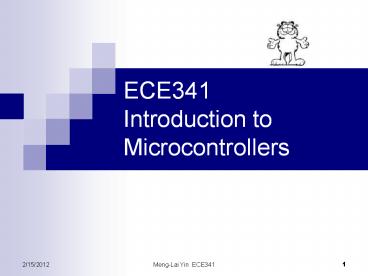ECE341 Introduction to Microcontrollers - PowerPoint PPT Presentation
1 / 16
Title:
ECE341 Introduction to Microcontrollers
Description:
No makeup tests (including quiz, midterm, and final) No cheating. Meng-Lai Yin ECE341 ... 2. Learn how to program a microcontroller with C language ... – PowerPoint PPT presentation
Number of Views:315
Avg rating:3.0/5.0
Title: ECE341 Introduction to Microcontrollers
1
ECE341Introduction to Microcontrollers
2
Grading
- 20 Homework
- 25 Quizzes
- 25 Midterm
- 30 Final
3
Rules
- Turn off cellular phones
- Be on-time for the lectures Labs
- No late homework
- No makeup tests (including quiz, midterm, and
final) - No cheating
4
What is in this class?
Assembly C
MC68HC11
- Microcontroller programming, applications, and
interfacing.
CME11E9-EVBU
5
Hardware Evaluation BoardMotorola 68HC11 EVBU
http//www.axman.com
Important!!!
You will need such an evaluation board next week
6
Objectives
- 1. Learn the architecture and instruction set of
a typical microcontroller - 2. Learn how to program a microcontroller with C
language - 3. Learn how to Interface external devices to a
microcontroller
7
(Official) Course Objectives
- After completing this course the student will be
able to - Explain the architecture and operation of a
microcontroller - Write simple assembly language programs to
perform basic functions like multi-byte addition
and subtraction. - Write C code to interface dip switches, 7 segment
displays and keypads to microcontrollers. - Write C code for ADC applications like digital
voltmeters. - Write C code for an on-chip timer in order to
implement a finite state machine like a traffic
controller. And then compare their design with
hardware implementations like ROM and FPGA
designs done in ECE 205. - Write C code to measure the period of a
squarewave using input capture and to control a
motor using pulse width modulation. - Write C code to communicate between two
microcontrollers using serial I/O protocol. - write C code to interface with keypad and LCD
display.
8
Languages Using
- Assembly language is used to explain the
architecture and instruction set of a
microcontroller. - C language is used in the applications
development.
9
A concept you MUST have
- Software and hardware development goes
hand-in-hand
10
A System View
High Level Language
Compiler
Object Code
Assembler
Machine Code
11
Microprocessors Microcontrollers
- Microprocessors are used widely in desktop
computers and embedded systems. - A microprocessor need external memories,
peripheral interfaces, etc. to build a complete
system. - A microcontroller incorporates a small amount of
memory, timers, A/D and D/A converters, and other
peripheral functions in one chip (along with the
CPU).
12
Features of the 68HC11A8 microcontroller
- 8-bit CPU - 256 bytes SRAM - 512 bytes
EEPROM - 8 KB ROM - 3 input capture channels - 5
output compare functions - one 8-bit pulse
accumulator - one serial communication interface
(SCI) - one serial peripheral interface
(SPI) - real-time interrupt (RTI)
circuit - 8-channel 8-bit A/D converter - computer
operate properly (COP) watchdog system
13
(No Transcript)
14
- Examples of microcontroller applications
- - Displays
- - Printers
- - Keyboards
- - Microwave ovens
- - Refrigerators
- - Washing machines
- - Automobile engine fuel injection
- - Fax machines
- - Motor speed control
- - etc.
15
Course Description
- 1. General introduction
- 2. Microcontroller Architecture
- a. Memory organization
- b. Instruction set and addressing modes
- c. Use of assembly language programming to
understand processor architecture - 3. Input/Output
- a. Programmed I/O
- b. I/O handshake
- c. Interrupt driven I/O
- d. Applications like multiplexed 7 segment
display, key padding, LCD interfacing - 4. Analog-To-Digital Conversion
- 5. On-chip timer
- a. Input capture
- b. Output compare
- c. Applications like PWM, speed measurement
- 6. Serial I/O
16
Plan






























